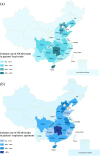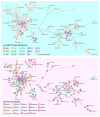Epidemiological and genetic characteristics of clinical carbapenem-resistant Acinetobacter baumannii strains collected countrywide from hospital intensive care units (ICUs) in China
- PMID: 35730377
- PMCID: PMC9258068
- DOI: 10.1080/22221751.2022.2093134
Epidemiological and genetic characteristics of clinical carbapenem-resistant Acinetobacter baumannii strains collected countrywide from hospital intensive care units (ICUs) in China
Abstract
Acinetobacter baumannii is one of the key Gram-negative pathogens that can cause serious nosocomial infections. In China, a large proportion of clinical A. baumannii strains are multidrug resistant, among which strains resistant to carbapenems are particularly worrisome, as infections caused by such strains may limit the choice of existing antibiotics. We conducted a nationwide and genome-based surveillance on the prevalence and antibiotic susceptibility profile of carbapenem-resistant A. baumannii (CRAB) strains collected from intensive care units (ICUs) in hospitals in different provinces and investigated the routes of transmission and mechanism of resistance by whole-genome sequencing and phylogenetic analysis. We found that CRAB strains were prevalent in 71.4% (55/77) of the ICUs surveyed. Clonal spread of CRAB was found in 37.6% (29/77) of ICUs and a total of 22 different clones were identified. Most clones were transmissible within one ICU, but up to six clones could be detected in at least three hospitals. In addition, carbapenem-hydrolysing class D β-lactamases (CHDL) were found to be mainly responsible for carbapenem-resistance in A. baumannii and the ST2 global-clone is the predominant type of CRAB in China. Importantly, we found that CRAB isolates currently exhibited an extremely low rate of resistance to colistin (0.4%) and tigecycline (2.5%), but a high rate of resistance to ceftazidime-avibactam (70.2%). Findings in this work shall facilitate development of appropriate antimicrobial regimens for treatment of CRAB infections. Further surveillance and research on the evolutionary and epidemiological features of clinical CRAB strains are necessary.
Keywords: Acinetobacter baumannii; OXA-23; carbapenem resistance; clonal transmission; molecular epidemiology.
Conflict of interest statement
No potential conflict of interest was reported by the author(s).
Figures






Similar articles
-
Phenotypic and molecular characterization of Acinetobacter baumannii isolates causing lower respiratory infections among ICU patients.Microb Pathog. 2019 Mar;128:75-81. doi: 10.1016/j.micpath.2018.12.023. Epub 2018 Dec 15. Microb Pathog. 2019. PMID: 30562602
-
Outbreak of carbapenem-resistant Acinetobacter baumannii carrying the carbapenemase OXA-23 in ICU of the eastern Heilongjiang Province, China.BMC Infect Dis. 2019 May 22;19(1):452. doi: 10.1186/s12879-019-4073-5. BMC Infect Dis. 2019. PMID: 31113374 Free PMC article.
-
Genomic Analysis of Carbapenem-Resistant Acinetobacter baumannii Strains Recovered from Chilean Hospitals Reveals Lineages Specific to South America and Multiple Routes for Acquisition of Antibiotic Resistance Genes.Microbiol Spectr. 2022 Oct 26;10(5):e0246322. doi: 10.1128/spectrum.02463-22. Epub 2022 Sep 26. Microbiol Spectr. 2022. PMID: 36154439 Free PMC article.
-
Prevalence of Acinetobacter baumannii in Saudi Arabia: risk factors, antimicrobial resistance patterns and mechanisms of carbapenem resistance.Ann Clin Microbiol Antimicrob. 2019 Jan 3;18(1):1. doi: 10.1186/s12941-018-0301-x. Ann Clin Microbiol Antimicrob. 2019. PMID: 30606201 Free PMC article. Review.
-
Multidrug-resistant Acinetobacter baumannii infections: looming threat in the Indian clinical setting.Expert Rev Anti Infect Ther. 2022 May;20(5):721-732. doi: 10.1080/14787210.2022.2016393. Epub 2021 Dec 27. Expert Rev Anti Infect Ther. 2022. PMID: 34878345 Review.
Cited by
-
Multicenter retrospective genomic characterization of carbapenemase-producing Acinetobacter baumannii isolates from Jiangxi patients 2021-2022: identification of a novel international clone, IC11.mSphere. 2024 Jun 25;9(6):e0027624. doi: 10.1128/msphere.00276-24. Epub 2024 Jun 4. mSphere. 2024. PMID: 38832781 Free PMC article.
-
Analysis of antimicrobial resistance and genetic diversity of Acinetobacter baumannii in a tertiary care hospital in Haikou City.Sci Rep. 2024 Sep 27;14(1):22068. doi: 10.1038/s41598-024-73258-2. Sci Rep. 2024. PMID: 39333332 Free PMC article.
-
Carbapenem is not always the best choice in the treatment of septic shock.Eur J Med Res. 2023 Sep 25;28(1):372. doi: 10.1186/s40001-023-01341-x. Eur J Med Res. 2023. PMID: 37749658 Free PMC article.
-
Molecular epidemiology of carbapenem-resistant gram-negative bacilli in Ecuador.BMC Infect Dis. 2024 Apr 6;24(1):378. doi: 10.1186/s12879-024-09248-6. BMC Infect Dis. 2024. PMID: 38582858 Free PMC article.
-
An integrative review on the risk factors, prevention, and control strategies for carbapenem-resistant Acinetobacter baumannii colonization in critically ill patients.Front Microbiol. 2025 Jan 10;15:1519906. doi: 10.3389/fmicb.2024.1519906. eCollection 2024. Front Microbiol. 2025. PMID: 39867493 Free PMC article. Review.
References
-
- Whiteway C, Breine A, Philippe C, et al. . Acinetobacter baumannii. Trends Microbiol. 2021;30(2):199–200. - PubMed
-
- Zilberberg MD, Shorr AF.. Secular trends in gram-negative resistance among urinary tract infection hospitalizations in the United States, 2000–2009. Infect Control & Hosp Epidemiol. 2013;34(9):940–946. - PubMed
-
- Goel N, Wattal C, Oberoi JK, et al. . Trend analysis of antimicrobial consumption and development of resistance in non-fermenters in a tertiary care hospital in Delhi, India. J Antimicrob Chemother. 2011;66(7):1625–1630. - PubMed
MeSH terms
Substances
LinkOut - more resources
Full Text Sources
Other Literature Sources
